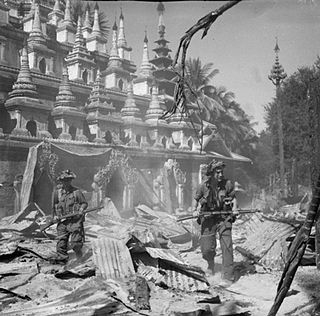
The King's African Rifles (KAR) was a multi-battalion British colonial regiment raised from British possessions in East Africa from 1902 until independence in the 1960s. It performed military and internal security functions within the colonial territories and served outside these territories during the world wars. The rank and file (askaris) were drawn from native inhabitants, while most of the officers were seconded from the British Army. When the KAR was first raised there were some Sudanese officers in the battalions raised in Uganda and native officers were commissioned towards the end of British colonial rule.

The British Fourteenth Army was a multi-national force comprising units from Commonwealth countries during the Second World War. As well as British Army units, many of its units were from the Indian Army and there were also significant contributions from British Army's West and East African divisions. It was often referred to as the "Forgotten Army" because its operations in the Burma Campaign were overlooked by the contemporary press, and remained more obscure than those of the corresponding formations in Europe for long after the war. For most of the Army's existence, it was commanded by Lieutenant-General William Slim.

The Second Australian Imperial Force was the name given to the volunteer expeditionary force of the Australian Army in the Second World War. It was formed following the declaration of war on Nazi Germany, with an initial strength of one infantry division and related auxiliary components. After considerable expansion of this force, three divisions were sent to the Middle East and North Africa, while the 8th Division was sent to garrison British Malaya and Singapore.

During the Second World War (1939–1945), India was a part of the British Empire. India officially declared war on Nazi Germany in September 1939. India, as a part of the Allied Nations, sent over two and a half million soldiers to fight under British command against the Axis powers. India also provided the base for American operations in support of China in the China Burma India Theater.

Almost every country in the world participated in World War II. Most were neutral at the beginning, but only a relatively few nations remained neutral to the end. The Second World War pitted two alliances against each other, the Axis powers and the Allied powers; the Soviet Union served 34 million men and women, Germany 18 million, the U.S 16 million, Japan 9 million, and Great Britain 6 million. It is estimated that in total, 127 million people were mobilised during the war. It is generally estimated that a total of 72 million people died, with the lowest estimate being 40 million dead and the highest estimate being 90 million dead. The leading Axis powers were Nazi Germany, the Empire of Japan and the Kingdom of Italy; while the British Empire, the United States and the Soviet Union were the "Big Three" Allied powers.
The Ghana Regiment is an infantry regiment that forms the main fighting element of the Ghanaian Army (GA).

The 5th Indian Infantry Division was an infantry division of the Indian Army during World War II that fought in several theatres of war and was nicknamed the "Ball of Fire". It was one of the few Allied divisions to fight against three different armies - the Italian, German and Japanese armies.

General Sir George James Giffard was a British military officer, who had a distinguished career in command of African troops in World War I, rising to command an Army Group in South East Asia in World War II.

The West African Frontier Force (WAFF) was a multi-battalion field force, formed by the British Colonial Office in 1900 to garrison the West African colonies of Nigeria, Gold Coast, Sierra Leone and Gambia. In 1928, it received royal recognition, becoming the Royal West African Frontier Force (RWAFF).

The 81st Division was formed under British control during the Second World War. It took part in the Burma Campaign.

The 82nd Division was formed under British control during the Second World War. It took part in the later stages of the Burma Campaign and was disbanded in Burma between May and September 1946.

The Nigerian Army (NA) is the land force of the Nigerian Armed Forces. It is governed by the Nigerian Army Council (NAC). The Chief of Army Staff is the highest ranking military officer of the Nigerian Army.

The Burma campaign in the South-East Asian Theatre of World War II was fought primarily by British Commonwealth, Chinese and United States forces against the forces of Imperial Japan, who were assisted to some degree by Thailand, the Burmese National Army and the Indian National Army. The British Commonwealth land forces were drawn primarily from the United Kingdom, British India and Africa.
The 1st Infantry Brigade was an infantry formation of the British Army during the Second World War. It was formed in 1940 from battalions of the Royal West African Frontier Force and served in the East African campaign against the Italians and against the Japanese in Burma.
The 2nd Infantry Brigade was a Second World War formation of the British Army. It was formed from battalions of the Royal West African Frontier Force in 1940. In the early part of the war, the Brigade served in the East African campaign before seeing action against the Japanese in Burma in 1944–45.

When the United Kingdom declared war on Nazi Germany in September 1939 at the start of World War II, the UK controlled to varying degrees numerous crown colonies, protectorates and India. It also maintained unique political ties to four of the five independent Dominions—Australia, Canada, South Africa, and New Zealand—as co-members of the then "British Commonwealth". In 1939 the British Empire and the Commonwealth together comprised a global power, with direct or de facto political and economic control of 25% of the world's population, and of 30% of its land mass.

The involvement of the British Colony of Kenya in World War II began with the declaration of war on Nazi Germany by the British Empire in September 1939.

Southern Rhodesia, then a self-governing colony of the United Kingdom that is located in the now-independent Zimbabwe, entered World War II along with Britain shortly after the invasion of Poland in 1939. By the war's end, 26,121 Southern Rhodesians of all races had served in the armed forces, 8,390 of them overseas, operating in the European theatre, the Mediterranean and Middle East theatre, East Africa, Burma and elsewhere. The territory's most important contribution to the war is commonly held to be its contribution to the Empire Air Training Scheme (EATS), under which 8,235 British, Commonwealth and Allied airmen were trained in Southern Rhodesian flying schools. The colony's operational casualties numbered 916 killed and 483 wounded of all races.
Kyari Magumeri also known as Chari Maigumeri was a Nigerian soldier who fought in both World Wars. During the Great War, Magumeri served in the German Army. He received an Iron Cross medal but was later captured in Garua. After his release, he joined the Nigerian regiment and fought on the British side. He retired in 1953 and was given the honorary title of Captain.

The Gambia Regiment was a British Army colonial regiment drawn from the Gambia Colony and Protectorate that existed between 1901 and 1958. Known as the Gambia Company from 1901 to 1939, and from 1945 to 1950, its strength fluctuated from peacetime and wartime, peaking at two battalions during World War II. It saw active service in both world wars, fighting in German colonies in Kamerun and East Africa during the first, and in Burma against the Japanese in the second. It was raised as part of the larger Royal West African Frontier Force, and was part of the 81st Division during its operations in WWII.



















